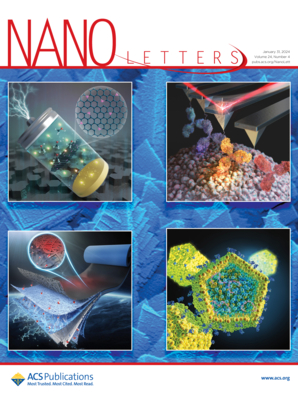Berry Curvature-Driven Valley Nernst Effect in Monolayer WSe2
IF 9.6
1区 材料科学
Q1 CHEMISTRY, MULTIDISCIPLINARY
引用次数: 0
Abstract
The Berry curvature in a Dirac cone causes anomalous transport phenomena, including anomalous Hall, anomalous Nernst, and Valley Hall effects. Detecting the Berry curvature in a 2D transition metal dichalcogenide (TMD) layer requires breaking time-reversal symmetry to create a population imbalance between the K+ and K– valleys. Direct observation and control of valley polarization in a 2D TMD layer remain challenging, especially for practical applications. Here, we present the first experimental verification of the Berry curvature-driven valley Nernst effect (VNE) in interlayer TMDs, focusing on the monolayer (ML) WSe2 in a Pt/YIG bilayer structure. Experiments and calculations show that our VNE signals result from the high Berry curvature of the ML WSe2 layer. This opens up a new way to generate spin- and valley-current-based thermoelectric devices.

狄拉克锥中的贝里曲率会导致反常输运现象,包括反常霍尔效应、反常奈恩斯特效应和谷霍尔效应。在二维过渡金属二钙化物(TMD)层中检测贝里曲率需要打破时间反向对称性,在 K+ 和 K- 谷之间产生种群失衡。直接观察和控制二维 TMD 层中的谷极化仍具有挑战性,尤其是在实际应用中。在此,我们首次通过实验验证了层间 TMD 中贝里曲率驱动的谷内效应 (VNE),重点研究了 Pt/YIG 双层结构中的单层 (ML) WSe2。实验和计算表明,我们的 VNE 信号来自 ML WSe2 层的高贝里曲率。这为产生基于自旋和谷电流的热电设备开辟了一条新途径。
本文章由计算机程序翻译,如有差异,请以英文原文为准。
求助全文
约1分钟内获得全文
求助全文
来源期刊

Nano Letters
工程技术-材料科学:综合
CiteScore
16.80
自引率
2.80%
发文量
1182
审稿时长
1.4 months
期刊介绍:
Nano Letters serves as a dynamic platform for promptly disseminating original results in fundamental, applied, and emerging research across all facets of nanoscience and nanotechnology. A pivotal criterion for inclusion within Nano Letters is the convergence of at least two different areas or disciplines, ensuring a rich interdisciplinary scope. The journal is dedicated to fostering exploration in diverse areas, including:
- Experimental and theoretical findings on physical, chemical, and biological phenomena at the nanoscale
- Synthesis, characterization, and processing of organic, inorganic, polymer, and hybrid nanomaterials through physical, chemical, and biological methodologies
- Modeling and simulation of synthetic, assembly, and interaction processes
- Realization of integrated nanostructures and nano-engineered devices exhibiting advanced performance
- Applications of nanoscale materials in living and environmental systems
Nano Letters is committed to advancing and showcasing groundbreaking research that intersects various domains, fostering innovation and collaboration in the ever-evolving field of nanoscience and nanotechnology.
 求助内容:
求助内容: 应助结果提醒方式:
应助结果提醒方式:


